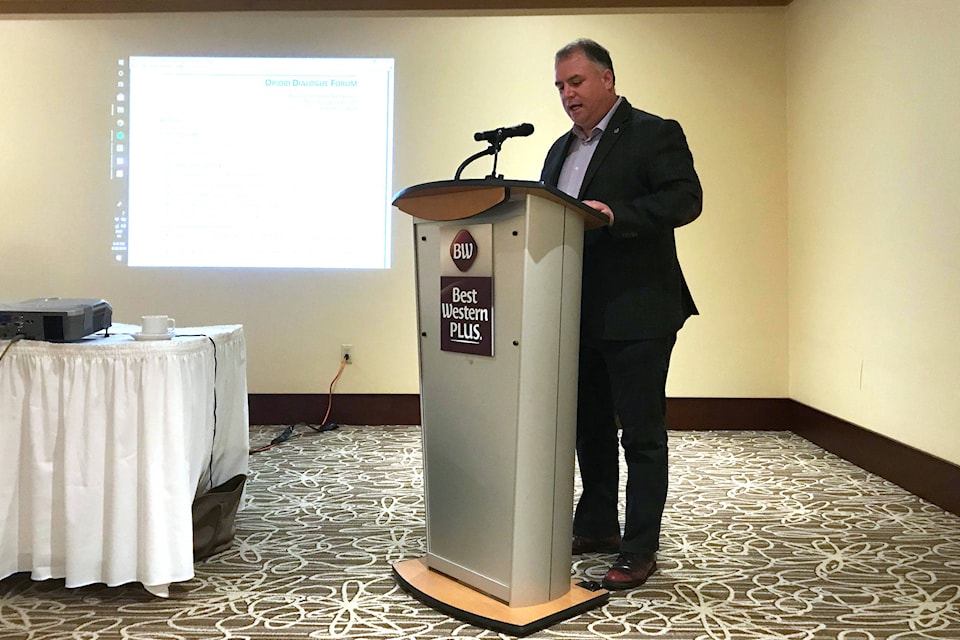Addiction should be treated as a medical issue, according to health professionals at last week’s opioid dialogue forum in Port Alberni.
The forum, which took place Thursday, Sept. 20 at the Best Western Hotel, was a “culmination” of a year of different dialogue initiatives put on by the Port Alberni Shelter Society, with help from a grant from the University of Victoria.
READ: It’s time to talk openly about opioid addictions, says Port Alberni Shelter Society
It brought together health professionals and people who have been touched personally by the opioid crisis to provide a community update and gather community input. Guest speakers agreed that the stigma around addiction needs to change.
Courtenay-Alberni MP Gord Johns called the opioid crisis the “single greatest emergency” facing the community right now. Since the crisis was declared in 2016, the community of Port Alberni has lost 23 people to overdoses—seven so far this year, says medical health officer Dr. Paul Hasselback.
“The Valley has a rate of death from overdose that’s about 50 percent higher than the province of British Columbia, which is about 50 percent higher or more than the rest of Canada,” Hasselback added on Thursday.
He estimated that despite 200 people who are currently in treatment for addiction, there are 400 individuals who are regularly using or injecting drugs, most of whom need to use three times a day or more in order to not have withdrawal symptoms.
Comox Valley residents John and Jennifer Hedican, who lost their 26-year-old son Ryan to an opioid overdose last year, drew a standing ovation from the small crowd at the Best Western. Ryan, whose substance use started while he was still in high school, struggled with the help of his family to find treatment, but was stopped by numerous wait-lists and roadblocks. Ryan passed away from fentanyl poisoning on April 24, 2017, shortly after moving out of a treatment centre in New Westminster.
READ: B.C. family advocating for drug decriminalization following death of son
“Addiction is nothing anyone chooses,” Jennifer emphasized on Thursday.
The Hedicans have started a petition calling for the decriminalization of drugs. The petition asks the federal government to declare the opioid crisis a national public health emergency, and also asks that a safe source of drugs be provided. John and Jennifer want addiction to be treated as a disease, not a choice—which means it will be treated, funded and supported like all other diseases.
Dr. Robbie O’Dwyer, who works in Internal Medicine at West Coast General Hospital, called addiction a “socio-medical problem” and said that it should not be criminalized. He took the time to explain the neurological effects of addiction. Opioids work by stimulating two different neurochemicals: endorphins, which provide painkilling, and dopamine, which makes you feel euphoric and motivated.
Addiction is the habitual response to this stimulus, he explained. An addict who uses opioids for 30 to 60 days on a regular basis will have created a neural pathway that is “permanent and fixed.”
“It’s a repetitive involvement with a substance, despite the substantial harm it causes you,” O’Dwyer said. “[Addicts] know they’re in big trouble. They know the drug is going to harm them. But they can’t stop themselves due to the psychological, mental pressure that’s coming from the way our minds and our consciousness works.”
Jon McDowell, an ambulance paramedic from Port Alberni, said his own opioid addiction started with Tylenol 3s, after surgery on his elbow in 2010. After a while, he stopped using the painkillers to relieve pain and started using them prophylactically. His dosage grew from two painkillers a day to 10. Despite attempts to stop his own addiction, withdrawals always led him back. After attending treatment, which he had to pay for by himself, he was able to get clean. Two years after attending treatment, he knows that using opioids again would send him down the same path.
“Nobody wants to be that revolving door person that needs help,” he said. “At a point, it becomes an obsession. You have to have it.”
Debra Hamilton, who works with Alberni Drug and Alcohol Prevention Service, says that there is a “low age of first utilization” in Port Alberni. It is also extremely difficult to get young people into treatment, as there are no specialized treatment beds for youth on the Island.
Conversation, she said, is key to preventing addiction. Earlier this year, Hamilton led a Harm Reduction Roundtable for Youth, where she met with more than 20 youth who had been affected by the overdose crisis.
“We know that when we engage youth in critical thinking and elevate their voice and ask them about their experiences, their knowledge and what their expertise is, we assist them in protecting themselves,” she said.
The forum on Thursday also had several optimistic notes. Approximately 60 doses of naloxone a month are being distributed within the community, with people trained and available to use it, said Hasselback. The overdose prevention site that opened in 2017 can now check for fentanyl, and two outreach teams in the community are providing support for addicts.
Hamilton is also the co-chair of Port Alberni’s provincially funded “Community Action Team,” an on-the-ground team established this year that works with existing community partners to deliver proactive and comprehensive care and support to people at risk of overdose.
“I really feel that in the face of this public health crisis, Port Alberni is in good hands,” she said on Thursday.
